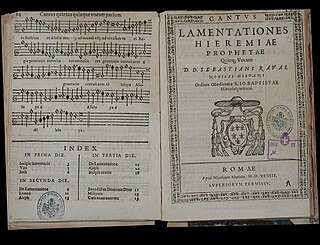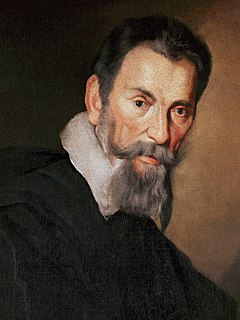
Claudio Giovanni Antonio Monteverdi was an Italian composer, string player and choirmaster. A composer of both secular and sacred music, and a pioneer in the development of opera, he is considered a crucial transitional figure between the Renaissance and the Baroque periods of music history.
In music, ornaments or embellishments are musical flourishes—typically, added notes—that are not essential to carry the overall line of the melody, but serve instead to decorate or "ornament" that line, provide added interest and variety, and give the performer the opportunity to add expressiveness to a song or piece. Many ornaments are performed as "fast notes" around a central, main note.

Adriano Banchieri was an Italian composer, music theorist, organist and poet of the late Renaissance and early Baroque eras. He founded the Accademia dei Floridi in Bologna.

A chaconne is a type of musical composition popular in the baroque era when it was much used as a vehicle for variation on a repeated short harmonic progression, often involving a fairly short repetitive bass-line which offered a compositional outline for variation, decoration, figuration and melodic invention. In this it closely resembles the passacaglia.

Salamone Rossi or Salomone Rossi was an Italian Jewish violinist and composer. He was a transitional figure between the late Italian Renaissance period and early Baroque.
Pomponio Nenna was a Neapolitan Italian composer of the Renaissance. He is mainly remembered for his madrigals, which were influenced by Gesualdo, and for his polychoral sacred motets, posthumously published as Sacrae Hebdomadae Responsoria in 1622.
Giovanni Bassano was an Italian composer associated with the Venetian School of composers and a cornettist of the late Renaissance and early Baroque eras. He was a key figure in the development of the instrumental ensemble at the basilica of San Marco di Venezia. His detailed book on instrumental ornamentation has survived. It is a rich resource for research in contemporary performance practice. Bassano was most responsible for the performance of the music of Giovanni Gabrieli, who would emerge as one of the most renowned members of the Venetian School.
Tarquinio Merula was an Italian composer, organist, and violinist of the early Baroque era. Although mainly active in Cremona, stylistically he was a member of the Venetian school. He was one of the most progressive Italian composers of the early 17th century, especially in applying newly developed techniques to sacred music.

Giovanni Legrenzi was an Italian composer of opera, vocal and instrumental music, and organist, of the Baroque era. He was one of the most prominent composers in Venice in the late 17th century, and extremely influential in the development of late Baroque idioms across northern Italy.

Sebastián Raval was a Spanish composer of vocal and instrumental music. Born in Cartagena, he served as a soldier of the Army of Flanders in Flanders and Sicily. He joined the order of St. John of Jerusalem after being wounded in the siege of Maastricht.
Giovanni Girolamo Kapsperger was a German-Italian virtuoso performer and composer of the early Baroque period. A prolific and highly original composer, Kapsberger is chiefly remembered today for his lute and theorbo (chitarrone) music, which was seminal in the development of these as solo instruments.

Giulio Castagnoli is an Italian composer.
Simone Molinaro was a composer of the late Renaissance in Italy. He was especially renowned for his lute music.

The Italian composer Claudio Monteverdi (1567–1643), in addition to a large output of church music and madrigals, wrote prolifically for the stage. His theatrical works were written between 1604 and 1643 and included ten operas, of which three—L'Orfeo (1607), Il ritorno d'Ulisse in patria (1640) and L'incoronazione di Poppea (1643)—have survived with their music and librettos intact. In the case of the other seven operas, the music has disappeared almost entirely, although some of the librettos exist. The loss of these works, written during a critical period of early opera history, has been much regretted by commentators and musicologists.
Giovanni Paolo Caprioli was an Italian priest, abbate in Candiana, and composer. Caprioli-Capriolo Giovanni Paolo. Born in Brescia in 1571 ca. and here she died in the convent of St. John the Evangelist during the plague in January 1630. The noble family from Brescia Caprioli is attested in documents citizens since the eleventh century. Gentlemen from the time of Henry III of the lands of Capriolo (BS), moved into town in the early fourteenth century living in different buildings but particularly in the palace Caprioli Via Elia Capriolo. The family was the birthplace of two important musicians: Alfonso Antonio Caprioli and John Paul that in 1587 she entered the convent of Scandiano (PD) belongs to the Congregation of the Rhenish Lateran Canons of SS. Savior of Bologna. In this religious order the severity and austerity of monastic life married with a keen sensitivity to the artistic decoration of the churches and a special interest in a cultural qualification through the study. Figures of great composers and organists will require a bit 'anywhere in the various convents of the Congregation, especially in Bologna, Mantua, Venice and Brescia, where, in the rectory of St. John is the strong influence of traditional instrumental and vocal production environment Brescia Renaissance and Baroque. Among the major players operating in the convent Brescia remember Floriano Channels, Angelo Maria from Peschiera, Leone from Bologna, Dionysius from Fano, Peter Knights, Giovanni Artusi, Pietro Andrea Ziani, Carlo Maffei and not least John Paul Caprioli which we can thank the studies of Oscar Mischiati retrace his monastic pilgrimage:

The Diocese of Aleria was a Roman Catholic diocese of the Latin rite, in the center of the eastern coast of the island of Corsica in the Department of Haute-Corse. The town of Aleria was subject to repeated raids by Arab fleets in the eighth and ninth centuries, and eventually abandoned, many of its people fleeing to the mainland. The bishop moved to a secure stronghold to the north. From at least the eleventh century, the diocese was a suffragan of the metropolitan archdiocese of Pisa. The diocese was suppressed by the Civil Constitution of the Clergy in 1790, and was not revived after the Concordat of 1801 between the French Consulate and the Papacy. It has been a titular diocese since 2002.

Mario Savioni was an Italian composer and a male alto of the Baroque era.
Emiliano Ramacci: Relazione dal XVII Convegno della Società Italiana di Musicologia (Pisa 2010).

















